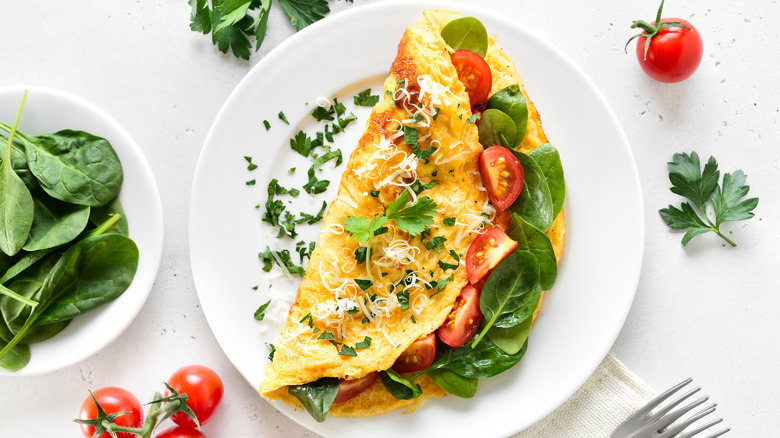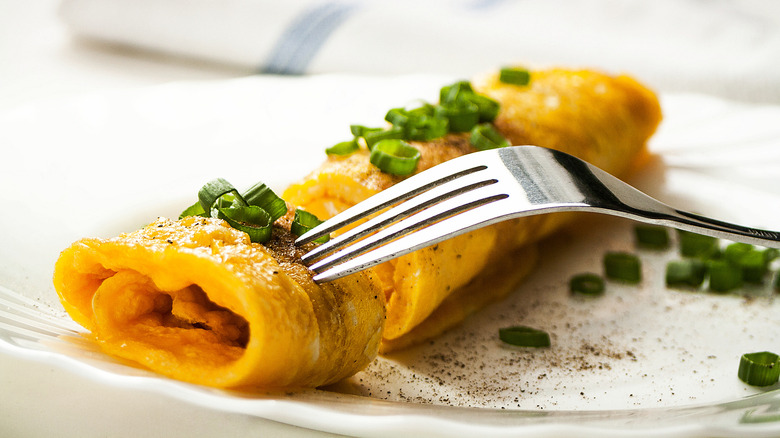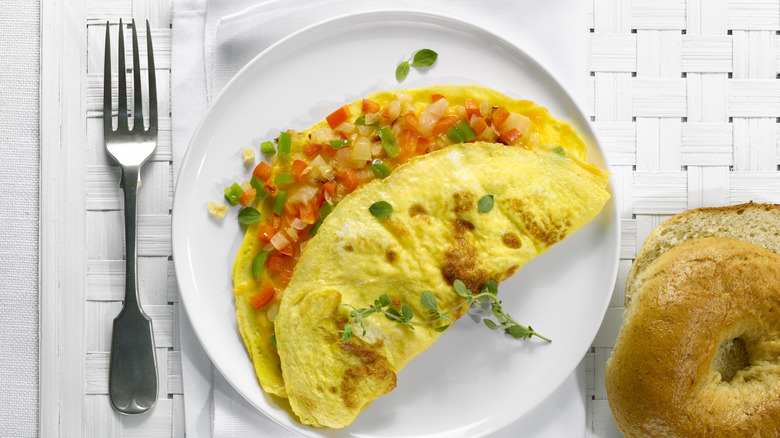The Difference Between A French And American-Style Omelet
We know what you're thinking: how different can these two national staples really be? The truth is, apart from the amount of eggs (3), the type of skillet (non-stick), and the fact that they taste delicious (especially with fillings), they're quite a bit different. In fact, they're not even spelled the same.
Chef-prepared American omelets are the stuff of greasy spoon diner legend. They feature a folded-in-half shape that usually takes up half a plate, are thoroughly cooked through, often to the point of brownness, and they are frequently fully loaded with other ingredients — so much so you might miss the fact that it's an egg dish.
A typical French omelette is all about technique, so much so that old-school chefs used to test prospective talent with their preparation. The eggs are cooked softly (browning would be considered a fail) and folded over each other gently until they resemble a rolled log or cigar. The result is a super smooth exterior with a very tender interior that might even look undercooked to American eyes. An utterly authentic French omelette won't have any fillings at all and white pepper is used over black to maintain the sleekly simple style.
We'll break these two dishes down into further detail below, but the long and short of it comes down to how the eggs are cooked and how much they are stirred. Which version is better is, of course, up to you to decide.
Everything you need to know about French omelettes
French omelettes are cooked in a very hot pan. Instead of lowering the heat as they cook, French chefs will simply move the pan onto or off of the heat source. When the butter is added it should foam but not brown. Before the eggs are added to the hot pan, they are beaten just up until no whites remain.
Now comes the finesse. The pan is so hot that when chefs add the egg mixture, it starts to set immediately, forming a very thin layer. They then quickly agitate the eggs, stirring them around the pan rapidly with a fork while moving the entire pan with their other hand. This technique is what creates a smooth omelette as no large curds can form. The evenly cooked eggs will start to look creamy on top as a solid layer forms on the bottom. At this point, they'll tilt the pan and start rolling the layer of eggs until it forms that cigar shape, before tipping it onto a plate seam-side down. The outside should be delicately set while the inside is still custardy.
Of course Michelin-starred chefs and home cooks alike play on the classic with a few additions. A fines herbes omelette mixes fresh tarragon, parsley, and chives into the eggs before cooking. For an omelette du fromage, sprinkle Gruyère cheese on top of your eggs before you start rolling. The effect will still look elegant and taste decadent.
How American omelets set themselves apart
Now you know that French omelettes mandate rapid agitation to create small curds and a custard-like result. For American omelets, we're looking for large, fluffy curds and a fully set interior, so we don't want to move our eggs around as much. Your pan should be over medium heat as opposed to high, though you still want your pan hot enough to melt your butter fully before adding your eggs.
Then, once you add your eggs, use a silicone spatula to lift or push the edges of your eggs into the middle of the pan. As you do so, tilt the pan to let some of the uncooked egg to run beneath the edges. Continue pushing, lifting, and filling until all the eggs are set. If you want your American omelet to more closely mimic the custardy texture of a French omelette, turn your heat to low and tackle this process as slowly as possible. Add your kitchen sink of toppings, from Denver to Southwest to Florentine, then fold your omelet in half and serve. Of course, a few twists of black pepper are totally welcome here. And all omelets, no matter their nationality, are best eaten immediately.
If you want to read more, be sure to check out some of our best omelet cooking tips.


